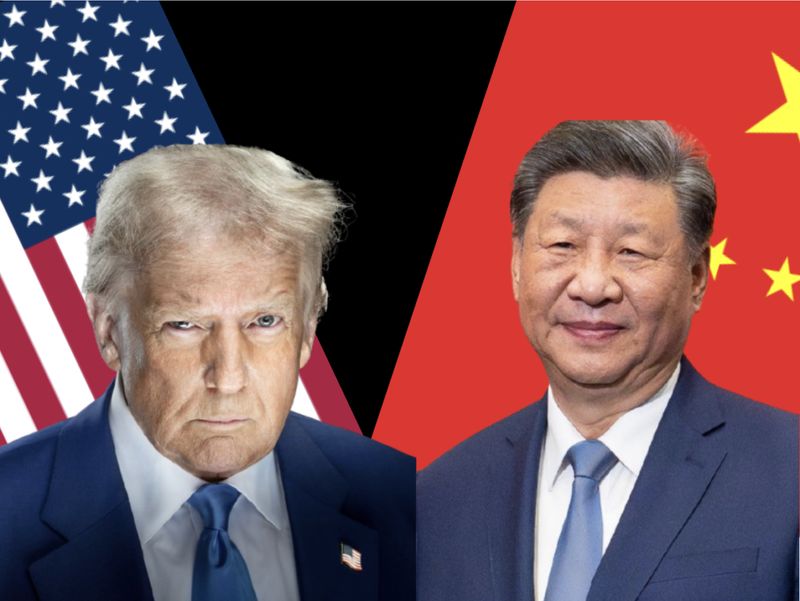The world may be standing on the brink of a major crisis as the US-China trade war escalates.
The long running US-China trade war, which reignited earlier in 2025 following Donald Trump’s return to the presidency, has escalated dramatically in the past week. Tensions involve rare earths, technology exports, and shipping fees and are being built upon existing tariffs which had only been partially de-escalated. This development comes even as Trump was supposed to meet President Xi Jinping at the sidelines of the APEC summit in Seoul later this month.
On October 9, in response to US restrictions on semiconductors and port fees on Chinese ships (introduced in April), China announced draconian export controls on rare earth minerals and related technologies. The immediate trigger for the Chinese move was a combination of escalating US trade restrictions and worries about misuse of Chinese rare earth materials.

On September 30, the US had broadened its export controls to include subsidiaries of targeted Chinese technologies companies and also prevent third country companies like Taiwan’s TSMC from supplying China with chips produced using US technology.
The sweeping Chinese controls set in a requirement of licenses for exports containing more than 0.1% rare earths or using Chinese production tech, effective December 1. Essentially under the new rules, foreign companies would need Beijing’s approval to export magnets that contain even trace amounts of Chinese sourced rare earth materials or those that were produced using the country’s extraction methods, refining or magnet making technology.
China dominates over 90% of global rare earth processing, vital for electronics, EVs, and defence tech. Beijing also imposed reciprocal “special port fees” on US-operated and US-built ships as a defensive measure.
In response, on October 10, President Trump announced an additional 100% tariff on all Chinese imports, effective November 1, 2025, on top of the existing 30% baseline tariffs imposed earlier this year for issues like fentanyl trafficking and unfair trade practices.
This could push effective rates to 130% or higher in some sectors. Trump has also proposed restricting US exports of critical software to China and has threatened to cancel the upcoming in-person meeting with President Xi at the APEC summit in South Korea later this month – their first since Trump’s inauguration.
Recall in April this year, a full blown trade war had erupted when Trump hit China with 145% tariffs and Xi retaliated with a 125 % tax on US goods. A May 2025 “ceasefire” agreement had lowered US tariffs to 30% and Chinese tariffs on US goods to 10%. This had involved a loosening of Chinese restrictions on rare earth magnets and minerals. However, simmering disputes over rare earth supplies and tech transfers have unraveled this.
China’s stance: Beijing has condemned the US tariffs as hypocritical “double standards,” arguing they undermine trade talks and harm mutual interests. An official spokesperson emphasised that tariff threats are not a constructive way to engage China, while defending the rare earth curbs as a “legitimate” compliance with international law to protect global stability – no outright bans, with approvals for compliant applications expected to have “very limited” supply chain effects.
Observers have pointed out that the restrictions announced by China on rare earths were a Chinese mirror version of the US foreign direct product rule, used to block semi-conductor related exports to China from third countries.
China has not yet announced new retaliatory tariffs but warned of further defensive actions if needed.
US perspective: Trump described China’s rare earth moves as “very hostile” and an attempt to hold the world “captive,” framing the tariffs as essential retaliation. He has urged US firms to re-shore production, citing recent investments in domestic manufacturing.
The US Trade Representative grumbled, “China is attempting to use economic coercion to influence American politics.” The world champion of economic coercion is calling out China, which, of course, also uses economic coercion, but nowhere near the scale of the US.
In practical terms, the Chinese move would enable China to control the entire world’s supply chains as rare earth minerals and magnets are critical for not only smart phones and electric vehicles and fighter jets, but also the semiconductor supply chain. US AI chips, made in a US fab or sent to a US AI lab, would need China’s permission.
Economic and market impacts
The Chinese and US announcements triggered selloff in US markets, akin to the one that came along with the so-called “Liberation Day” tariffs on April 2. Besides the S&P, Dow and Nasdaq declining substantially, it resulted in higher gold prices and a slide in crypto markets.
Experts are warning that Trump’s tariffs could backfire on the US for a variety of reasons. A well known investor, Steve Eisman, has warned that a trade war with China could well trigger a recession.
Despite efforts at diversification, the Chinese still hold massive leverage in relation to rare earths. China controls 70 % of the global supply of rare earth minerals and 90% of their processing.
Countries are undertaking crash measures to avoid Chinese restrictions and are investing heavily in domestic rare earth production. But it will take them a decade or more for them to get going. The US’s MP Materials, for example, is opening a new magnet plant in Texas using US-sourced rare earths, Noveon Magnetics also in Texas is getting supplies from Australia and the US War Department is investing $400 million to secure and stabilise prices.
High tariffs are not the magic bullet that Trump assumes it is. He believes that by hitting China with 130% tariffs he can bring it to its knees. The truth lies somewhere else.
In a paper in Foreign Affairs earlier this year, Adam Posen argued that the fact that China exported (2024) some $439 billion worth of goods to the US while the latter exported $143 billion gave leverage to China. The reason is that the US was not doing China a favour in buying these goods; the Americans wanted what China was making and so, if those goods become much more expensive or vanish from the US market, it is Americans who will suffer.
That’s the reason why Trump exempted iPhones and computer equipment from his first round of tariffs. The scale of Chinese exports are enormous. 80% of air conditioners, 75 % of electric fans, or 75% of dolls and cycles coming for Christmas are made in China. The Tax Foundation estimates that overall Trump tariffs could amount to an $1300 annual tax on American households. Theoretically all these can be made in the US, but it would take time to set up the factories and the goods would, in any case, be more expensive.
Besides consumer goods, the Chinese leverage extends to the fact that 50% of the ingredients that go into antibiotics that the US depends on comes from China. Besides rare earths, China also produces more than 80% of the world’s tungsten and this is actually more important than rare earths as it is not substitutable in machining and drilling and is needed in automotive, aerospace, manufacturing and defence.
The American leadership is under an illusion that the Chinese are hugely dependent on American markets. That is simply not true. The US market represents just about 14 % of Chinese exports, something that the $15 trillion economy can easily absorb. Of course there will be pain, such as that in the area of civil aviation components for its fleet of US-made passenger aircraft.
In its response to the Chinese moves on rare earths, Trump issued a long post in Truth Social to speak on behalf of the community of nations. He said that the Chinese move “affects ALL Countries” and was “a moral disgrace in dealing with other Nations.” The problem is that the manner in which Trump has treated “ALL Countries” means the latter are unlikely to sympathise with the US on the tariff issue. Nor are they likely to participate in US plans to develop alternate supply chains since the US seems to be determined to control all of them.
The Chinese are also vulnerable to US restrictions. They are almost completely dependent on high-end AI and smartphone chips from the US, as well as smartphone operating systems. Chinese firms rely on more than 90% of US-based providers of essential AI and cloud computing capabilities. In addition, 75% of Chinese commercial aviation is dependent on US firms for key subsystems and components.
So the world may be standing on the brink of a major crisis as the US-China trade war escalates. With the Trump-Xi meeting at risk and tariffs looming in weeks, escalation seems the more likely option unless last-minute diplomacy intervenes. A pending US Supreme Court case next month could limit US tariff powers, but for now, uncertainty reigns, fragmenting global freight and pressuring supply chains. These developments could be negotiating strategies with both sides playing hardball before arriving at a trade deal, but it could also take the already stressed international trade system over the edge.
The writer is a Distinguished Fellow, Observer Research Foundation, New Delhi.
This piece was first published on The India Cable – a premium newsletter from The Wire – and has been updated and republished here. To subscribe to The India Cable, click here.
This article went live on October fourteenth, two thousand twenty five, at fifty-four minutes past eight in the morning.
The Wire is now on WhatsApp. Follow our channel for sharp analysis and opinions on the latest developments.
